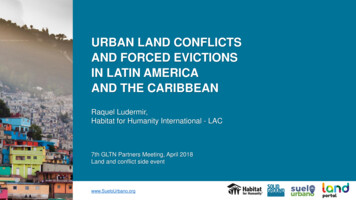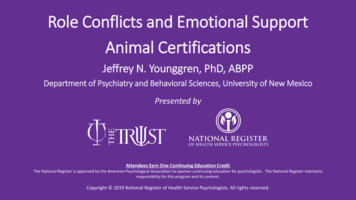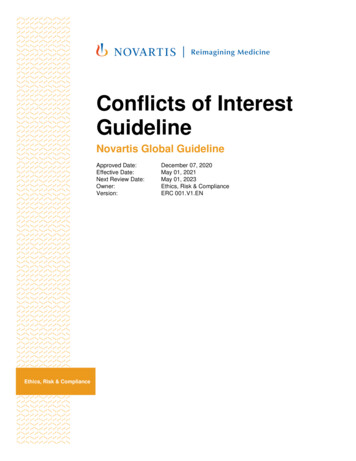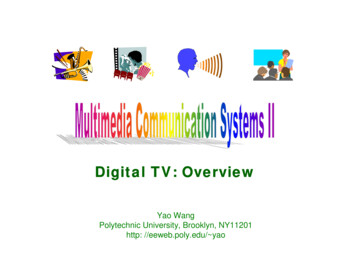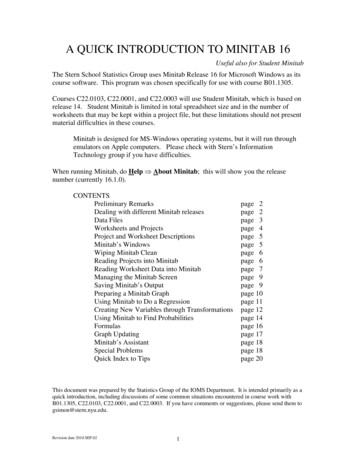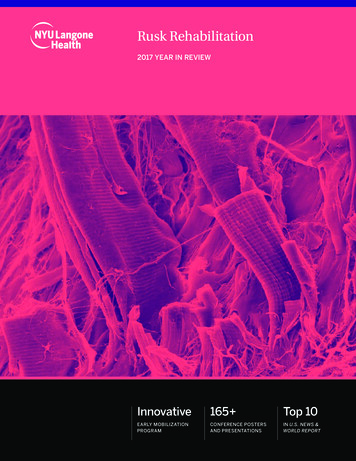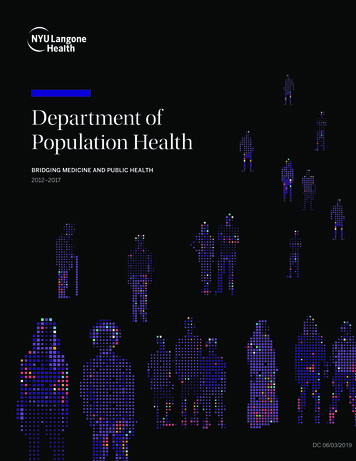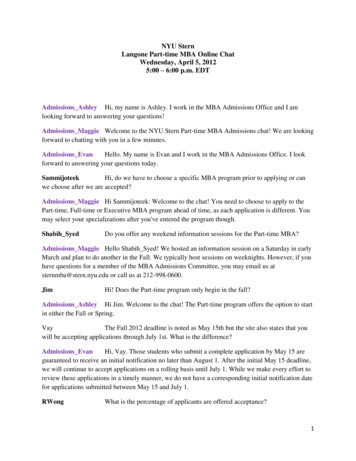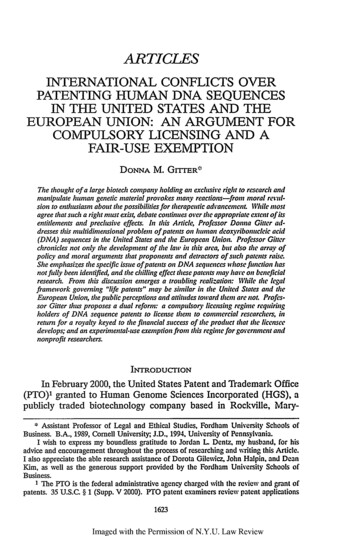
Transcription
ARTICLESINTERNATIONAL CONFLICTS OVERPATENTING HUMAN DNA SEQUENCESIN THE UNITED STATES AND THEEUROPEAN UNION: AN ARGUMENT FORCOMIPULSORY LICENSING AND AFAIR-USE EXEMPTIONDONNA M. GrrrERThe thought of a large biotech company holding an exclusive right to researchandmanipulatehuman genetic materialprovokes many reactions-from moral revulsion to enthusiasmabout the possibilitiesfor therapeuticadvancement. While mostagreethat such a right must exist, debate continues over te appropriateextent of itsentitlements and preclusive effects. In this Article Professor Donna Gitter addresses this multidinensionalproblem of patents on huntman dcoxyribonucleic acid(DNA) sequences in the United States and the European Union. ProfessorGitterchronicles not only the development of the lai in this area, but also tie arrany ofpolicy and moral arguments that proponents and detractors of such patents raise.She emphasizes the specific issue ofpatents on DNA sequences whose fincdon hasnot fully been identified,and the cilling effect these patents may have on beneficialreseardcL From this discussion emerges a troubling realization: While the legalframework governing "life patents" may be similar in the United States and tieEuropean Union, the public perceptionsand attitudestoward them arenot. Professor Gitter thus proposes a dual reforn: a compulsory licensing regime requiringholders of DNA sequence patents to license them to conmmercial researchers,inreturnfor a royalty keyed to the financialsuccess of the product that tie licenseedevelops; and an experimental-use exemption from this regime for government andnonprofit researchers.INTRODUCTIONIn February 2000, the United States Patent and Trademark Office(PTO)' granted to Human Genome Sciences Incorporated (HGS), apublicly traded biotechnology company based in Rockville, Mary* Assistant Professor of Legal and Ethical Studies, Fordham University Schools oBusiness. B.A., 1989, Cornell University, J.D., 1994, University of Pennsylvania.I wish to express my boundless gratitude to Jordan L Dentz, my husband, for hisadvice and encouragement throughout the process of researching and writing this Article.I also appreciate the able research assistance of Dorota Gilewicz, John Halpin, and DeanKim, as well as the generous support provided by the Fordham University Schools ofBusiness.1 The PTO is the federal administrative agency charged with the review and grant ofpatents. 35 U.S.C. § 1 (Supp. V 2000). PTO patent examiners review patent applications1623Imaged with the Permission of N.Y.U. Law Review
1624NEW YORK UNIVERSITY LAW REVIEW[Vol. 76:1623land,2 a patent for the CCR5 receptor gene, 3 described in an HGSpress release as one "that produces what is believed to be the criticalentry point [into cells] for the AIDS virus."'4 While patenting theCCR5 receptor gene may represent an important technologicalachievement, the patenting of human deoxyribonucleic acid (DNA)sequences in general is quite common under current biotechnologypatent law. Since the 1980s, thousands of human DNA sequenceshave been patented worldwide. 5 As of September 1, 2001, HGS aloneheld 180 patents on human gene-based inventions and had filed applications for many more, both in the United States and abroad.6 Giventhe extent of such patenting activity, it is no surprise that biotechnology patent law and policy provoke such controversy. Indeed, the patenting of human DNA sequences generates intense internationaldebate, particularly in the technologically advanced United States andEuropean Union (E.U.). 7 The HGS patent on the CCR5 receptorgene serves as a quintessential example of how complex the legal issues surrounding patents on human DNA sequences have become.Debate has centered on several key issues. First, there is sharpinternational disagreement as to whether the genetic code that defineshuman life satisfies the threshold criteria of patentability-that an inin order to determine whether the claimed inventions satisfy the legal requirements ofpatentability. 1 Donald S. Chisum, Chisum on Patents, at OV-1 (2000 & Supp.).2 Human Genome Sciences, Inc., LEXIS, News Library, Hoover's Company ProfileDatabase File. HGS was founded in 1992. Id.3 See infra Part I.C for a general discussion of the composition and function of genes,the methods geneticists employ to identify them, and what geneticists hope to accomplishby understanding their role.4 Nell Boyce & Andy Coghlan, Your Genes in Their Hands, New Scientist, May 20,2000, at 15; see also Sabra Chartrand, A Human Gene is Patented as a Potential ToolAgainst AIDS, But Ethical Questions Remain, N.Y. Times, Mar. 6,2000, at C9; Eliot Marshall, Patent on HIV Receptor Provokes an Outcry, Sci. Now, Feb. 23, 2000, at 000/223/1; Paul Smaglik, Could AIDS Treatments Slip Through Patents Loophole?, 404 Nature 322, 322 (2000); Michael Valdholz,Rights to Life: Genes Are Patentable; Less Clear Is If Finder Must Know Their Role, WallSt. J., Mar. 16, 2000, at Al.5 Molly A. Holman & Stephen R. Munzer, International Property Rights in Genes andGene Fragments: A Registration Solution for Expressed Sequence Tags, 85 Iowa L. Rev.735, 750 (2000); Telephone Interview with Brigid Quinn, Deputy Director of the Office ofPublic Affairs, United States Patent and Trademark Office (July 11, 2001) (stating thatPTO has granted approximately 1200 patents for full-length genes).6 Human Genome Sciences-Patents, at http:/www.hgsi.comlpatents/index.htmi (lastmodified Sept. 10, 2001). As of November 2000, HGS had more than 7500 patents pendingfor human genes. Tim Radford, Human Genetic Patenting: Microbes Make Millions in aNew Klondyke of Microfactories, Guardian (U.K.), Nov. 15, 2000, at 4.7 The fifteen member states of the E.U. are Austria, Belgium, Denmark, Finland,France, Germany, Greece, Ireland, Italy, Luxembourg, the Netherlands, Portugal, Spain,Sweden, and the United Kingdom. See Richard Schaffer et al., International Business Lawand Its Environment 88 (4th ed. 1999).Imaged with the Permission of N.Y.U. Law Review
December 2001]PATENTING HUMAN DNA SEQUENCES IN U.S. AND E.U. 1625vention constitute patentable subject matter and be novel.8 In theUnited States, judicial law and administrative law have affirmed thepatentability of human DNA sequences in general. Certain E.U.member states, however, continue to harbor moral and ethical objections to such patents, despite a recent E.U. legislative enactment thatprovides that human DNA sequences are indeed patentable. The difference in perspective between the United States and the E.U. withrespect to patents on human DNA sequences threatens internationalscientific collaboration, and, consequently, harmonious internationalrelations. This tension is heightened as U.S. biotech companies increasingly seek patent protection in Europe in order to recoup theirconsiderable costs of research and development.Second, even assuming arguendo that human DNA sequences arepatentable, U.S. and E.U. institutions continue to grapple with howliberally to interpret the second patent law criterion, "utility," whichrequires a patent applicant to articulate the function of the claimedinvention. 9 Many patent applications are for DNA sequences of unknown function. For example, HGS was unaware of the CCR5 gene'srole in the HIV virus at the time the company applied for its patent.10HGS knew only of CCR5's general role as a receptor, or entry pointinto the cells, and "was expecting instead to exploit the patent primarily in the development of anti-inflammatory therapy." 1 Not untilabout a year after HGS filed its patent application did severalindependent research teams, working without help from HGS, publishSee infra Part II for a description of this threshold criteria.9 See infra Part III.B for a discussion of the utility criterion of patentability, termed"industrial applicability" in the E.U.; see also infra note 146.10 Quirin Schiermeier, German Agencies Sound Alarm on Risks of Broad Gene Patents . 406 Nature 111, 111 (2000). One writer has explained the functioning of theCCR5 receptor as follows:Receptors are found on the surface of cells, much like pins sticking out of a pincushion, and act as a sort of docking port, sometimes for lethal viruses. But thereceptor and the virus have to match, like a key and a lock. CCR5 is known tofit the AIDS virus. The virus binds to the receptor, then fuses to the cell, andfusion allows 1IV to work its way inside.Chartrand, supra note 4.11 Smaglik, supra note 4, at 322. HGS filed its patent application for the CCR5 gene asa so-called "homologous sequence," Le., a gene sequence of unknown utility whose biological function can be predicted because it is similar to a separate sequence whose function isalready understood. See David Dickson, NIH Opposes Plans for Patenting 'Similar' GeneSequences, 405 Nature 3, 3 (2000). Scientists locate such sequences by using computers tohypothesize "the identity and function of a protein encoded by a gene based on the similarity of a [gene] fragment to other known genes." Id.; see also Martin Enserink, PatentOffice May Raise the Bar on Gene Claims, 287 Science 1196, 1197 (2000). HGS had deduced the CCR5 gene's general role as a receptor by performing computer analysis ofsequence information made public by the Human Genome Project. See Boyce & Cog/lan,supra note 4, at 15. For a description of the Human Genome Project, see infra note 16.8Imaged with the Permission of N.Y.U. Law Review
NEW YORK UNIVERSITY LAW REVIEW[Vol. 76:1623pivotal experiments demonstrating that CCR5 is required for efficient12replication of the HIV virus.Some scholars and researchers contest, on the grounds of utility,HGS's right to a patent for the CCR5 receptor gene, given that HGSwas unaware of the gene's role in the HIV virus at the time the com-pany obtained its patent.' 3 This dispute over how to interpret the utility criterion transcends national borders and pits U.S. and E.U.scholars and researchers from the public and nonprofit sectors, 14 onone hand, against private biotech companies on the other. The formercontend that excessively lenient application of the utility criterion withrespect to human DNA sequences ultimately will hinder research, because the need to pay licensing fees to the patentee will dissuadescientists from conducting further experimentation relating to patented genes. For example, a University of Pennsylvania bioethicisthas warned that HGS's patent on the CCR5 receptor gene, and thecompany's attendant right to collect royalties from subsequent researchers working on the gene, will impede others from developingtherapeutics based on the gene. 15 The biotech industry counters that,absent the limited monopoly furnished to inventors through the extantpatent system, firms will not invest in the costly research and development that is so vital to the creation of new pharmaceutical products.This tension between the for-profit and nonprofit communities replicates itself on a meta-international scale, pitting international bodiessuch as the Human Genome Project (HGP) 16 against multinationalbiotech companies.12 Boyce & Coghlan, supra note 4, at 15; Smaglik, supra note 4, at 322; Waldholz, supranote 4. HGS, in contrast, did not disclose its work publicly because it had contracted toprovide its gene database exclusively to SmithKline Beecham PLC in return for a paymentof 135 million. Id.13 Waldholz, supra note 4.14 This group sometimes includes academic researchers, although academic researchhas become increasingly commercialized since the mid-1980s. See Arti Kaur Rai, Regulating Scientific Research: Intellectual Property Rights and the Norms of Science, 94 Nw. U.L. Rev. 77, 110 & n.186 (1999) (noting increase in academic-industrial biotech partnershipssince 1980s and citing examples); see also Sheldon Krimsky, The Profit of Scientific Discovery and Its Normative Implications, 75 Chi.-Kent L. Rev. 15, 15-22 (1999) (describingtrend toward alliances among for-profit and academic researchers).15 Boyce & Coghlan, supra note 4, at 15.16 The HGP, also called the "public project," is an international, publicly financed consortium of academic centers that are sequencing and studying the human genome. AlexBerenson & Nicholas Wade, A Call for Sharing of Research Causes Gene Stocks toPlunge, N.Y. Times, Mar. 15, 2000, at Al; Richard Preston, The Genome Warrior, NewYorker, June 12, 2000, at 66, 66. The HGP began in 1990, funded with public money allocated by Congress and coordinated by the National Institutes of Health (NIH), a governmental biomedical research institute, and the U.S. Department of Energy. See LeslieRoberts, DOE's Genome Project Comes of Age, 252 Science 498, 498 (1991); J. CraigVenter et al., The Sequence of the Human Genome, 291 Science 1304, 1305 (2001). NowImaged with the Permission of N.Y.U. Law Review
December 2001] PATENTING HUMAN DNA SEQUENCES IN U.S. AND L.U. 1627Finally, U.S. and E.U. scholars and scientists from the public andnonprofit sectors assert that a patent such as the one held by HGS onthe CCR5 receptor gene fails to satisfy the third major patent criterion: "nonobviousness."'1 7 They contend that the methods employedby biotech companies to isolate the genes that these companies thenseek to patent are obvious in light of the "prior art."18 Specifically,HGS employed computerized homologous sequencing techniques toidentify the CCR5 receptor gene by comparing the gene to other similar, or homologous, genes. 19 Many researchers who perform geneticanalysis through experimental, rather than computational, work rejectthese computerized research methods that do not involve "'gettingyour pipette wet,'"0 contending that they "'require little scientific insight or creativity."'21 Dr. William Haseltine, HGS's chief executiveofficer, has responded by arguing that computational gene searchesrequire much effort.22This Article will explore the aforementioned legal and public policy issues raised by patents on human DNA sequences. Part I is abasic primer on the science of human DNA sequencing and the usesto which it is applied. Part II examines the law and policy relating tothe patentability of life forms in general, and human DNA sequencesin particular, under U.S. and E.U. law. This Part concludes that whilethe United States and the E.U. both have responded to the competitive pressure to increase patent protection for human DNA sequences, an abiding E.U. suspicion of such patents lingers. Thefundamental differences between the U.S. and E.U. positions on thepropriety of patenting human DNA create significant internationalthe HGP is largely financed by the NIH and the Wellcome Trust of London, the largestnonprofit medical research foundation in the world. Berenson & Wade, supra; Preston,supra, at 71. Richard Preston points out that "[o]ne of the founding principles of theHuman Genome Project was the immediate release of all the human genetic code that wasfound, making it available free of charge and without any restrictions on who could useit . " Id. The HGP posts its findings daily on GenBank, a World wide Web site available to the public. GenBank Overview, at w.html (last visited July 5, 2001).17 See infra Part IV. In the E.U., nonobviousness is termed "inventive step." See infranote 146.Prior art "includes any relevant knowledge, acts, descriptions and patents which pertain to, but predate, [the] invention in question." Black's Law Dictionary 1193 (6th ed.1990).19 See supra note 11.20 Enserink, supra note 11, at 1197 (quoting critic of computerized process).21 Dickson, supra note 11, at 3 (quoting Jordan J. Cohen, president of Association ofAmerican Medical Colleges).22 See Smaglik, supra note 4, at 322.18Imaged with the Permission of N.Y.U. Law Review
NEW YORK UNIVERSITY LAW REVIEW[Vol. 76:1623tension, 23 and limit the potential for effective U.S.-E.U. harmonization of biotech patent protection. Part III examines the utility criterion and the international conffict that arises as a result of oppositionby members of the public sector and nonprofit research communitiesin the United States and Europe to the patenting of human DNA sequences of unknown utility. The implementation of a solution acceptable in both the United States and Europe is necessary to fosterinternational scientific collaboration. Part IV discusses the criterionof nonobviousness. As with utility, this criterion has provoked apitched debate among the public sector and nonprofit research communities in the United States and the E.U. This debate must be resolved in order to facilitate the sharing of cross-border research data.Finally, Part V proposes a means of addressing the conflicts engendered by patents on human DNA sequences: Congressional enactment of compulsory-licensing legislation, coupled with codification ofan experimental-use exemption. A compulsory-licensing scheme, withfees set on a sliding scale depending upon the commercial value of theinvention, would ensure royalties for inventors while permitting further use of their research. An experimental-use exemption wouldguarantee public sector and nonprofit scientists the opportunity to engage in research for noncommercial purposes. The combination ofthese remedies effectively would protect intellectual property rightswhile simultaneously fostering international scientific cooperation.ITHEA.SCIENCE OF HUMANDNASEQUENCINGThe Distinction Between Genome Patenting and Gene PatentingTo understand the controversy in the United States and the E.U.surrounding the patenting of human DNA sequences, it is essential todistinguish between the human genome-the total human complement of DNA present in each of our cells24-which cannot be pat23 Much of the pressure to liberalize European gene patenting law comes from theUnited States. The chairman of the U.S. pharmaceutical firm Pfizer has criticized Europe'sreluctance to do so, stating: "Europe seems to be entering a period of the dark ages, wherewitchcraft and sorcery are prevailing." James Meek, The Race to Buy Life: Carve Up ofthe Human Heart: Universities and Charities Are Rushing to Isolate and Patent HumanGenes Before It Is Even Understood What They Do, Guardian (London), Nov. 15, 2000(internal quotation marks omitted), available at LEXIS, Nexis Library, The Guardian File;see also infra notes 194-212 and accompanying text (describing conflicts between UnitedStates and various E.U. member states over patents on human DNA sequences).24 R. Scott Hawley & Catherine A. Mori, The Human Genome: A User's Guide 8(1999). The genome consists of forty-six deoxyribonucleic acid (DNA) molecules, whichcontain the chemical units that determine an individual's hereditary characteristics. Id. atImaged with the Permission of N.Y.U. Law Review
December 2001]PATENTING HUMAN DNA SEQUENCES IN U.S. AND EU.1629ented,25 and particular sections of DNA, called genes, 26 which can bepatented.27 Many people in the United States and the E.U. erroneously conflate the terms "genome" and "gene." 28 For example, onMarch 14, 2000, former U.S. President Bill Clinton and British PrimeMinister Tony Blair issued a joint statement addressing patent policywith respect to sequencing the human genome.2 9 Clinton and Blairdeclared that "raw fundamental data on the human genome, includingthe human DNA sequence and its variations, should be made freelyavailable to scientists everywhere."30 Interpreting the statement as apolicy shift toward greater restrictions on the patentability of humanDNA sequences, investors dumped the stocks of biotechnology companies around the world, eliminating tens of billions of dollars in market value.31 In fact, Clinton and Blair merely had intended to clarifythe existing patent regimes in their respective nations at a point intime when scientists were drawing close to completing a working draftof the genome's entire sequence.3 2 In short, in both the Unit
I also appreciate the able research assistance of Dorota Gilewicz, John Halpin, and Dean Kim, as well as the generous support provided by the Fordham University Schools of Business. 1 The PTO is the federal administrative agency charged with the r
